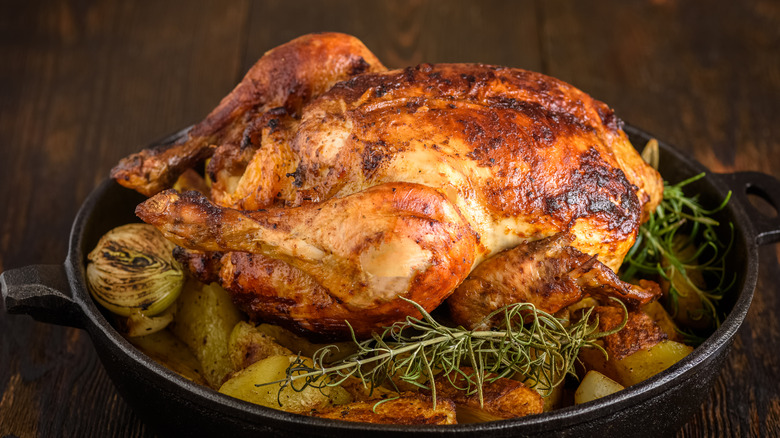Why You Should Avoid Reheating Chicken More Than Once
While it might be debatable what the most delicious type of meat is, the most popular is, you might guess, chicken. According to Statista, more than 132 million tons of poultry meat were consumed around the globe in 2021. That outranked pork, beef, and every other kind of meat.
Most meat eaters will testify that chicken is delicious, and bonus, it's also nutritious. Additionally, the meat stands up to being cooked in almost every way you can imagine. We have 101 different ways to cook chicken ourselves, but that hardly scratches the surface. Chicken can be grilled, roasted, poached, steamed, sauteed, smoked, and cooked in any other way that you can imagine.
That doesn't mean that cooking chicken is easy though. The University of Wyoming Extension points out that chicken does have a nasty habit of drying out more easily than you'd expect, which means you'll need to proceed with some caution.
Here's why chicken tends to dry out
According to The University of Wyoming Extension, the reason that chicken dries out is that it has so little fat. WebMD points out that this lack of fat is what makes chicken such a great source of nutrition compared to other meats. While it's still loaded with protein and other beneficial nutrients, it's not as likely to add unnecessary fat to a recipe.
Taste of Home says that one way to avoid dry chicken starts in the grocery store aisle. Plenty of people are quick to grab the boneless, skinless chicken breasts, but might be better off with the opposite. Keeping the skin on your chicken breast protects it from direct heat, and also adds more moisture to the meat while it's cooking. This will help keep it from drying out, and the skin can easily be removed after it's cooked if you'd like.
The University of Wyoming Extension says that using a brine or a marinade can help add extra moisture as well. It's also important to not overcook your chicken. The United States Department of Agriculture (USDA) says that chicken needs to be cooked to 165 degrees Fahrenheit for safe consumption, but you can safely take the meat off the heat at around 160 degrees to let the internal temperature rise as it rests without taking any safety risks.
Now you're armed with the proper chicken cooking knowledge, but that doesn't mean the precautions stop there.
How to reheat chicken
Chicken's bad habit of drying out doesn't stop once it's cooked. Whenever you're reheating your chicken, you'll have to be careful to avoid it drying it out once more.
Food Network says that one way to avoid this is to only reheat leftover chicken once. Each time you reheat chicken you're losing more of that precious moisture in the meat. So, while it might be safe to reheat chicken multiple times, it's going to lose flavor every time you do (via USDA). The best way to avoid this is to only take out as much leftover chicken as you're going to eat. This way, you'll only be reheating each piece of chicken just before it's consumed, and will avoid drying out the meat.
Reviewed says that it's also best to avoid high heat when reheating chicken as this will easily dry out any leftover meat, and leave you with an unappetizing meal. Instead, it's best to wrap it in foil to trap the moisture and reheat it using moderate heat in either a toaster oven or a traditional oven. If that's not an option, then try the microwave, but remember to add a damp paper towel to add moisture inside the appliance while your food reheats.


